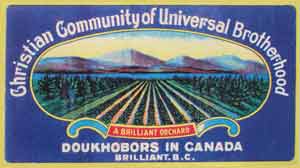The Brilliant Jam Factory
Among the many enterprises of the Doukhobor communities of The Christian Community of Universal Brotherhood under the leadership of Peter Lordly Verigin the most remembered is their Kootenay-Columbia Preserving Works Jam Factory in Brilliant, British Columbia
.
Arriving to B.C. in 1908, within three years their impressive industrial and agricultural progress included planting 51,000 fruit trees. Also in 1911 they ventured into jam making with the purchase of the Kootenay Jam Company factory in Nelson. As the communities increased their production of berries and fruit, they constructed a new factory in Brilliant in 1915 with double the production capacity. This factory included an operation to make tin cans and lids for jam distribution. In 1916 they made 150,000 cans.
The new K-C Brand factory had 12 special steam heated copper jam-making kettles able to process fresh berries the same day they were picked in the community fields of Brilliant, Ootishenia, Pass Creek, Glade, Shoreacres and the Slocan Valley. Grand Forks shipped their fruit to the factory by rail.
The strict grading of the incoming berries and fruit, along with cleanliness produced exceptional jams. In its making, nothing else was used but fresh berries and fruit with pure cane sugar in the old English recipe introduced to the K-C Brand operation by jam-maker Harry Beach in 1911.
By 1919,1,000 acres of fruit and berries were added to keep the $100,000 factory working at its capacity. Later in time long rows of raspberry bushes covered many acres of land near Brilliant. Today these acres make up the residential subdivision of Raspberry.
Following the death of Peter Lordly Verigin in 1924, his son Peter Chistiakov Verigin arrived from Russia in 1927 to assume the administrative post. The following year he enlarged the factory to 24 jam-making kettles and opened a larger market for berries to not only Doukhobor communities but to district farmers including those in the Slocan Valley and others living along Kootenay Lake as far as Creston.
In 1934 the factory had a jam pack of 35,000 cases. It had 10,000 cases of strawberry jam that led in popularity, followed by plum and raspberry. Other delicious flavours included cherry, apricot, peach, currant and gooseberry. Each case had 12 four pound cans of jam. This Brilliant factory was the first in Canada to commercially offer huckleberry jam when 2,000 cases were shipped to the prairies. Also during the 1930's depression years an economy priced strawberry and apple jam was made for bargain shoppers. The same year, in 1934, factory salesman William J. Soukereff sold 18 railway freight cars of jam in eastern Canada in a single trip, attesting to the popularity of its superb quality.
At peak season the factory employed about 60 people. The operation was capable of producing 1,055 cans of jam per hour for shipments of up to 43,000 cases annually. This operation was supervised by Peter P. Zibin from 1915 to 1935 and later by William J. Makaeff.
In 1935 another jam factory was constructed in Grand Forks. This factory with its inventory of jam, sugar and tin cans valued at $75,000 was destroyed by terrorists the same year. Eight years later, in 1943 the Kootenay-Columbia Preserving Works Jam Factory in Brilliant was also destroyed by terrorists. Its value was $300,000.
William M. Rozinkin
With permission from "Hospitality, Cooking the Doukhobor Way, 1995"


